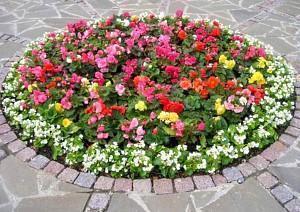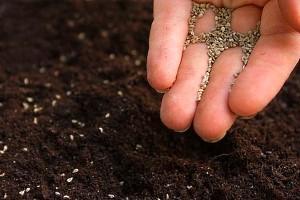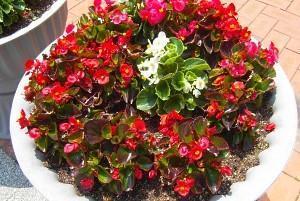How to properly grow ever-flowering begonia
 Many flower lovers often wonder, is it possible to grow begonia yourself without buying its seedlings? In fact, evergreen begonia from seeds reproduces beautifully and this process is interesting and exciting for every gardener. Almost all varieties of this plant retain the characteristics of their variety when propagated by seeds, but the ever-flowering double begonia in this case loses its hereditary characteristics.
Many flower lovers often wonder, is it possible to grow begonia yourself without buying its seedlings? In fact, evergreen begonia from seeds reproduces beautifully and this process is interesting and exciting for every gardener. Almost all varieties of this plant retain the characteristics of their variety when propagated by seeds, but the ever-flowering double begonia in this case loses its hereditary characteristics.
For sowing ever-flowering begonia you will need:
- flower seeds;
- priming;
- seedling boxes;
- glass.
The soil mixture for sowing seeds should be soft and rich in nutrients. This mixture can be found in any store that specializes in flowers.
 Sowing of ever-flowering begonia should be done in January. Since the seeds of this plant are very small, they can be mixed with regular sand for easy sowing. Boxes for growing from seeds of ever-flowering begonia should be shallow.
Sowing of ever-flowering begonia should be done in January. Since the seeds of this plant are very small, they can be mixed with regular sand for easy sowing. Boxes for growing from seeds of ever-flowering begonia should be shallow.
After the soil mixture is prepared, the seeds are scattered directly over the surface of the moistened and compacted soil. It is not advisable to fill them with soil mixture. In order to maintain the moisture required for good seed germination, the seed box is covered with glass. Drops that form on it must be wiped off in order to avoid seed decay. To prevent this situation, you can put containers in which ever-flowering begonia grows at a slight slope. Until the seeds germinate, the glass can be covered with paper to provide shade.
Dry land in greenhouse
After 10-12 days, the glass is slightly raised on the supports, and when normal shoots appear, this usually happens after 2 weeks, the glass is removed completely. After that, the temperature in the room where the seedlings are located is reduced to + 17-19 degrees C and the seedlings are shaded so that bright sunlight does not fall on them.
When 3-4 well-formed leaves appear, it is time for seedling picks... And a month later, begonias are planted in separate pots. Naturally, the plants need feeding.
You can buy organic fertilizer at a specialty store. In early May, the seedlings of ever-flowering begonia begin to harden, for this they are taken out into the street for a while. In early June, begonia seedlings are planted in open ground. In this case, the distance between plants should be approximately 10 cm, and between rows of flowers from 13 cm.
How to grow ever flowering begonia?
When growing this beautiful flower, you need to follow some rules: despite the photophilousness of begonia, placing it in the open sun is contraindicated, as well as hitting the flower with sunlight. This is especially dangerous during the flowering periods of begonia. How to grow ever-flowering begonia correctly, and what temperatures are needed for good growth and flowering of the plant?
Planting site and soil
Begonia will be grateful to you for a sunny but shaded place in the summer heat. Only with the shade you need to be careful, since from a lack of light, the stems of the plant can stretch out, lose their decorative properties and color of flowers.Begonia loves soil fertile and loose, enriched with humus, with a weakly acidic reaction (PH 6.2).
On soils with a high alkali content, it will grow poorly, possibly due to chlorosis or other diseases. The soil layer should be loose, because begonias have a superficial root system, which is why they like to use this plant for landscaping rocky hills. Looking at the photo of ever-flowering begonias, you immediately have a desire to acquire this plant in your garden. She is so attractive.
Fertilization and watering
 If the summer is dry, the begonias need to be regularly watered. It is better to water it in the early morning or with the onset of coolness in the evening. The water should already be settled and soft. Watering is moderate and it must be taken into account that begonia does not like stagnant water and also dry out the earth.
If the summer is dry, the begonias need to be regularly watered. It is better to water it in the early morning or with the onset of coolness in the evening. The water should already be settled and soft. Watering is moderate and it must be taken into account that begonia does not like stagnant water and also dry out the earth.
Caring for the ever-flowering begonia is simple and does not take much time, and the flowers of this beautiful plant will cheer you up with their bright colors. Most importantly, do not forget to pamper her with fertilizers for flowering plants containing minerals, loosen the ground and remove weeds once every 14 days.
You need to start feeding as soon as the buds appear. And if there is a desire to keep the ever-flowering begonia until the next warm season, the mother plants of this plant should be transplanted into pots and brought into the house for the winter even before the onset of cold weather. Ever-flowering begonia at home will delight with its flowering until spring, if you allocate it a well-lit place and do not forget to water.
Propagation of begonias with ever-flowering cuttings
It is possible to grow begonias not only from seeds, there is another way of propagation of ever-flowering begonias - cuttings.
 Open field begonia is cut in summer. For a growing house, the beginning of spring is chosen.
Open field begonia is cut in summer. For a growing house, the beginning of spring is chosen.
Cuttings:
- young leaves of ever-flowering begonia are cut from the stem with a sharp knife in order to facilitate the process of rooting growth;
- the cutting is placed in a moistened substrate and covered with polyethylene. It is also possible to place a strong and ripe leaf of ever-flowering begonia in a container of water.
In order for the ventilation process to take place, it is necessary to make holes with a knife in the plastic wrap of the greenhouse. A mixture of sand and expanded clay with perlite or moss is suitable as a substrate. After 14 days in a well-moistened soil, the cuttings develop roots. After another two weeks, the rooted begonia cuttings, freed from the film, should be transplanted into separate containers. Further care takes place according to the technique of growing begonias from seeds. During transplanting into open ground, the seedlings need to be deepened into the ground 2 cm below the level of its growth in a pot.